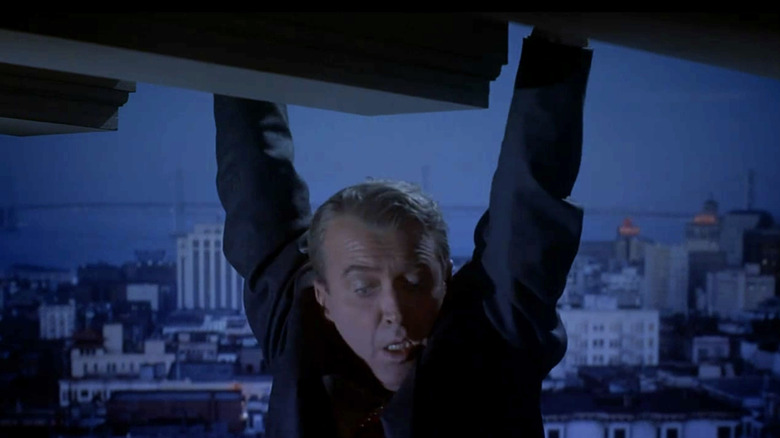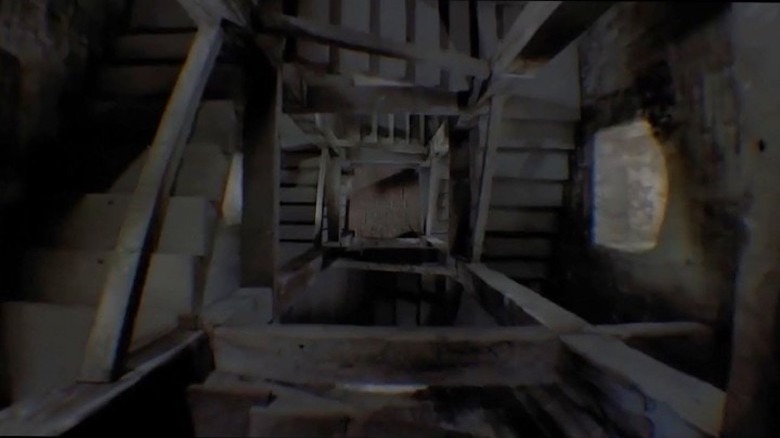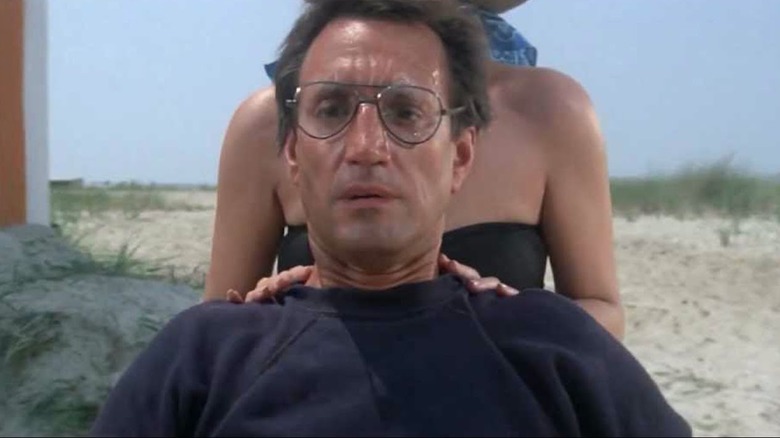Vertigo's Signature Shot Cost Almost $20,000 To Pull Off
Time has been kind to Alfred Hitchcock's "Vertigo." Dismissed as dull and middling by the critics of 1958, "Vertigo" was named the greatest film of all time by Sight & Sound in 2012. Experimental films can take a while to receive due praise, and "Vertigo" is definitely one of Hitchcock's more experimental films. He even invented a whole new type of shot for it.
In the film's opening, Scottie Ferguson (James Stewart) is hanging off a skyscraper and glances stories down to the alleyway beneath. When he does, the shot distorts and the buildings on opposite sides of the alley seem to stretch. The effect was achieved by mounting a camera on a dolly track and then zooming in on the lens while moving the dolly backward. As a result, the subject of the shot remained in focus while the background of the frame distorts. While this camera trick is most accurately called a "dolly zoom," it's also sometimes called the "Vertigo effect" in a nod to its origin.
The shot is used a few more times throughout the movie to communicate Scottie's, well, vertigo to the audience. That doesn't mean the shot wasn't easy to create; it took some creative thinking and a pretty penny to pull off the Vertigo effect.
Pulling off the dolly zoom
In François Truffaut's famous "Hitchcock/Truffaut" book, the two eponymous directors discuss the origins of the dolly zoom. Hitchcock revealed that he first had the idea for the shot while shooting "Rebecca." As Hitchcock explained:
"When Joan Fontaine fainted at the inquest in 'Rebecca,' I wanted to show how she felt that everything was moving far away from her before she toppled over. I always remember one night at the Chelsea Arts Ball at Albert Hall in London when I got terribly drunk and I had the sensation that everything was going far away from me. I tried to get that into 'Rebecca,' but they couldn't do it. The viewpoint must be fixed, you see, while the perspective is changed as it stretches lengthwise."
According to Hitchcock, he held onto the idea for the shot but couldn't think of a solution until "Vertigo." On that shoot, the second unit cameraman Irmin Roberts devised the zoom + dolly combo, while Hitchock was able to get the price down from the initial cost estimate. Hitchcock recounted:
"They told me it would cost fifty thousand dollars. When I asked why, they said, 'Because to put the camera at the top of the stairs we have to have a big apparatus to lift it, counterweight it, and hold it up in space.' I said, 'There are no characters in this scene; it's simply a viewpoint. Why can't we make a miniature of the stairway and lay it on its side, then take our shot by pulling away from it? We can use a tracking shot and a zoom flat on the ground.' So that's the way we did it, and it only cost us nineteen thousand dollars."
Considering how impressive the shot is, that $19,000 was money well spent.
Lasting impact
The most famous dolly zoom to follow from "Vertigo" is in Steven Spielberg's "Jaws." Here, it comes during the second shark attack of the movie, when young Alex Kintner (Jeffrey Voorhees) is killed a few yards from shore. When Chief Brody (Roy Scheider) sees the attack, the scene cuts to a medium close-up of him sitting down. That's when Spielberg and his cinematographer Bill Butler pull off the dolly zoom.
The effect is even clearer here than it is in "Vertigo" because there's a human subject (Brody) in the center of the frame, who remains static even as the image around him distorts. Brody may be still, but his mind is moving at a mile a minute. That's all communicated by the contrast between his static face and the blurring background. John Williams' score compliments the moment, leaping from the shark's "dun dun" theme to a higher pitched, Bernard Herrmann-esque string note.
Martin Scorsese, who has spoken highly of "Vertigo" many times, used a slower-paced dolly zoom in "Goodfellas." Near the movie's end, an anxious Henry Hill (Ray Liotta) meets Jimmy Conway (Robert De Niro) at a diner, all the while suspecting his old pal wants to silence him. Scorsese and DP Michael Ballhaus start with a center-framed medium-wide shot of the two men sitting on opposite ends of the booth, then slowly zoom in as the dolly tracks out inch by inch, creating a subtle "Vertigo effect" that lasts over 30 seconds. The irony: a film famous for flashy camera movement and barnstorming style takes one of the most audacious, mechanically elaborate shots ever and plays it for subtlety.
Hitchcock had a specific use for the dolly zoom when he conceived it, but his successors like Spielberg and Scorsese proved there's different ways to wield it.


